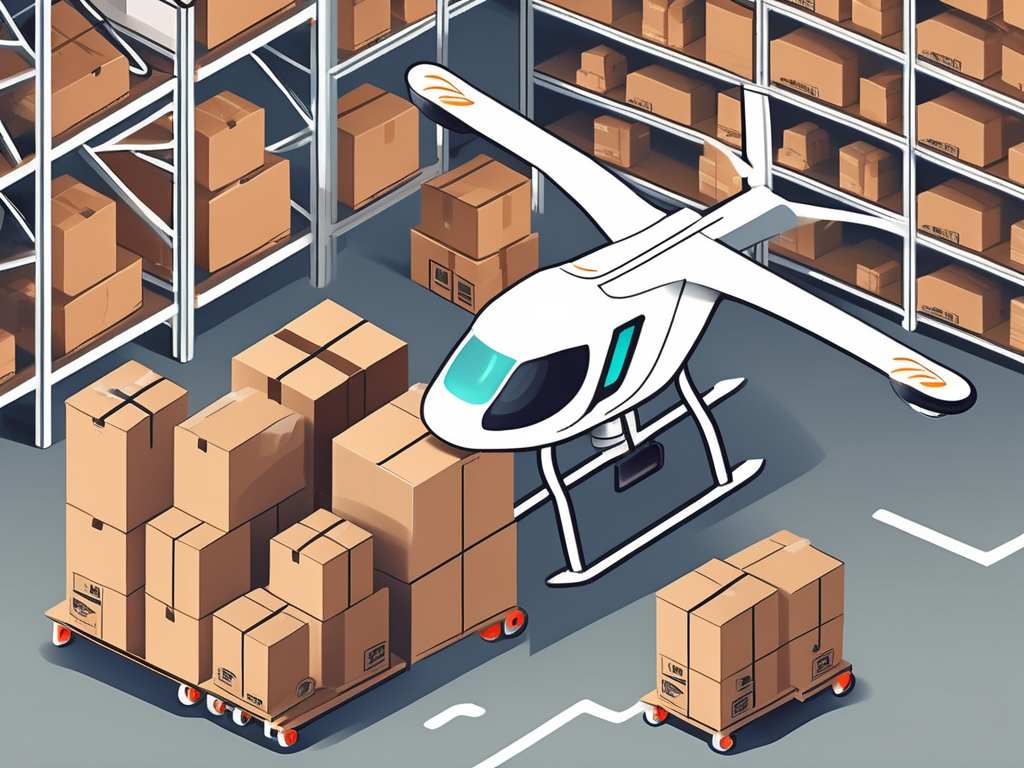Dropshipping is a popular business model that has gained significant traction in recent years. This method allows entrepreneurs to sell products online without having to worry about inventory management or order fulfillment. Amazon, being the world’s largest online marketplace, provides a perfect platform for dropshippers to showcase their products and reach a wide customer base. In this ultimate guide, we will walk you through the basics of dropshipping on Amazon, how to get started, finding the right products, identifying reliable suppliers, and managing your Amazon dropshipping business effectively.
Understanding the Basics of Dropshipping
Before diving into the world of dropshipping on Amazon, it’s essential to understand what dropshipping is and how it works. By definition, dropshipping is a business model where the store owner does not keep the products in stock. Instead, when a customer places an order, the store owner purchases the item from a third-party supplier, who then directly ships it to the customer. This eliminates the need for storing inventory or dealing with the hassle of shipping and handling.
What is Dropshipping?
Dropshipping is a business model that allows you to run an online store without having to handle inventory or ship products. You essentially act as the middleman between the customer and the supplier, earning a profit on each sale. This makes dropshipping an attractive option for entrepreneurs looking to start an online business with minimal upfront investment.
How Does Dropshipping Work?
The dropshipping process involves several key steps. First, you set up an online store, listing products from suppliers that you want to sell. When a customer places an order on your store, you forward the order details to the supplier, who then ships the products directly to the customer. You earn a profit by charging a higher price than the supplier’s wholesale price.
Pros and Cons of Dropshipping
Like any other business model, dropshipping has its advantages and disadvantages. On the plus side, dropshipping allows you to start an online business with minimal upfront costs and no need to hold inventory. It also gives you the flexibility to work from anywhere and choose from a wide range of products to sell. However, it also comes with challenges such as fierce competition, supplier issues, and potential customer service complexities.
One of the major advantages of dropshipping is the low barrier to entry. Unlike traditional retail businesses that require significant capital to purchase inventory, with dropshipping, you only need to pay for the products once you have received payment from your customers. This means that you can start your online store with minimal upfront investment, making it an appealing option for aspiring entrepreneurs.
Another benefit of dropshipping is the flexibility it offers. Since you don’t need to hold inventory, you have the freedom to work from anywhere as long as you have an internet connection. This means that you can run your business from the comfort of your own home, a coffee shop, or even while traveling. The ability to work remotely gives you the opportunity to create a lifestyle that suits your preferences and allows for a better work-life balance.
However, dropshipping also comes with its fair share of challenges. One of the main challenges is the fierce competition in the dropshipping market. As dropshipping has gained popularity, more and more entrepreneurs are entering the space, making it increasingly difficult to stand out from the crowd. To succeed, you need to find a niche market or unique selling proposition that sets you apart from your competitors.
Supplier issues can also pose a challenge in dropshipping. Since you rely on third-party suppliers to fulfill orders, any problems they encounter can directly impact your business. Issues such as stock shortages, delayed shipments, or poor product quality can lead to dissatisfied customers and damage your reputation. It’s crucial to carefully vet and establish strong relationships with reliable suppliers to minimize these risks.
Lastly, dropshipping can present customer service complexities. As the middleman between the customer and the supplier, you are responsible for handling customer inquiries, complaints, and returns. Providing excellent customer service is essential for building trust and loyalty with your customers. However, managing customer expectations and resolving issues can be time-consuming and require effective communication skills.
Getting Started with Amazon Dropshipping
Now that you understand the basics, it’s time to dive into the specifics of dropshipping on Amazon. To get started, you’ll need to set up an Amazon seller account and familiarize yourself with the platform’s dropshipping policies.

Setting Up Your Amazon Seller Account
Setting up an Amazon seller account is straightforward. You’ll need to provide necessary information such as business details, bank account information, and a valid credit card. Additionally, you may need to complete a verification process to ensure you’re a legitimate seller.
When setting up your Amazon seller account, it’s important to pay attention to the details. Make sure to accurately fill in your business information, as this will be visible to potential customers. Take the time to create a compelling seller profile that highlights your expertise and commitment to customer satisfaction. This will help build trust with buyers and increase the likelihood of successful sales.
Understanding Amazon’s Dropshipping Policy
Amazon has specific guidelines and policies regarding dropshipping. It’s crucial to familiarize yourself with these policies to avoid potential issues or account suspension. Some key points to remember include not selling counterfeit or restricted products, ensuring that the products are delivered in a timely manner, and providing top-notch customer service.
When it comes to dropshipping on Amazon, transparency is key. Clearly communicate to your customers that the products they are purchasing will be shipped directly from a supplier. This helps manage their expectations and minimizes the risk of negative feedback or returns due to misunderstandings.
Another important aspect of Amazon’s dropshipping policy is maintaining a high level of customer satisfaction. Respond promptly to customer inquiries, address any concerns or issues, and strive to exceed their expectations. By providing exceptional customer service, you can build a positive reputation as a reliable seller, which can lead to repeat business and positive reviews.
Finding the Right Products for Dropshipping
One of the critical factors for success in dropshipping on Amazon is finding the right products to sell. Conducting thorough product research and evaluating profitability are key steps before listing any items on your store.

Researching Product Trends
Keeping up with the latest product trends can give you a competitive edge. Look for products that have a steady demand and are not already saturated by other sellers. Tools such as Google Trends or Amazon’s Best Sellers list can help you identify popular and trending products.
For example, let’s say you’re considering selling fitness equipment. By using Google Trends, you can see that there has been a consistent increase in searches for home workout equipment over the past year. This indicates a growing interest in fitness products that can be used at home, presenting a potential opportunity for your dropshipping business.
Additionally, exploring Amazon’s Best Sellers list can provide valuable insights into what products are currently in high demand. By analyzing the categories and subcategories, you can identify niches that are not yet saturated and have the potential for profitability.
Evaluating Product Profitability
While choosing products, it’s essential to assess their profitability. Take into account factors such as production costs, shipping fees, and potential competition. Calculating the profit margin can help you determine whether a particular product is worth selling.
Let’s dive deeper into the profitability evaluation process. Suppose you’re considering selling smartphone accessories. Start by researching the production costs of the items you plan to sell. This includes the cost of sourcing the products, packaging, and any additional customization you may require.
Next, consider the shipping fees associated with the products. If you’re dropshipping from a supplier located overseas, shipping costs may be higher, impacting your overall profit margin. It’s crucial to find a balance between competitive pricing and maintaining a healthy profit margin.
Lastly, evaluate the potential competition for the products you’re interested in. Research other sellers offering similar items and analyze their pricing strategies, customer reviews, and overall market presence. This information will give you a better understanding of the competitive landscape and help you position your dropshipping business effectively.
By thoroughly researching product trends and evaluating profitability, you can increase your chances of success in dropshipping. Remember, finding the right products is the foundation of a profitable and sustainable business.
Identifying Reliable Suppliers
Having reliable suppliers is crucial to ensure smooth order fulfillment and maintain customer satisfaction. Follow these tips to find and build relationships with trustworthy suppliers.
Criteria for Choosing Suppliers
When selecting suppliers, consider factors such as product quality, pricing, shipping times, and their reputation in the industry. Look for suppliers who have a track record of delivering high-quality products and excellent service.
Building Relationships with Suppliers
Building strong relationships with your suppliers is beneficial for long-term success. Communicate clearly, provide feedback, and establish trust. By maintaining a good relationship, you’re more likely to receive priority support and possibly negotiate better pricing or shipping terms.
Managing Your Amazon Dropshipping Business
Once your Amazon dropshipping business is up and running, it’s crucial to manage it effectively to ensure its continued growth and success.

Handling Order Fulfillment
Efficient order fulfillment is key to providing excellent service. Automate order processing as much as possible, and ensure that orders are dispatched promptly. Regularly review your inventory levels to avoid selling out-of-stock items.
Dealing with Returns and Refunds
Handling returns and refunds is inevitable in any e-commerce business. Create a clear and customer-friendly return policy, and be diligent in addressing customer inquiries or complaints. This will help maintain a positive reputation and customer satisfaction.
By following these steps and implementing effective strategies, you can build a successful dropshipping business on Amazon. Remember, it takes time and effort to establish yourself in the competitive marketplace, but with the right approach and continuous learning, the possibilities are limitless.

